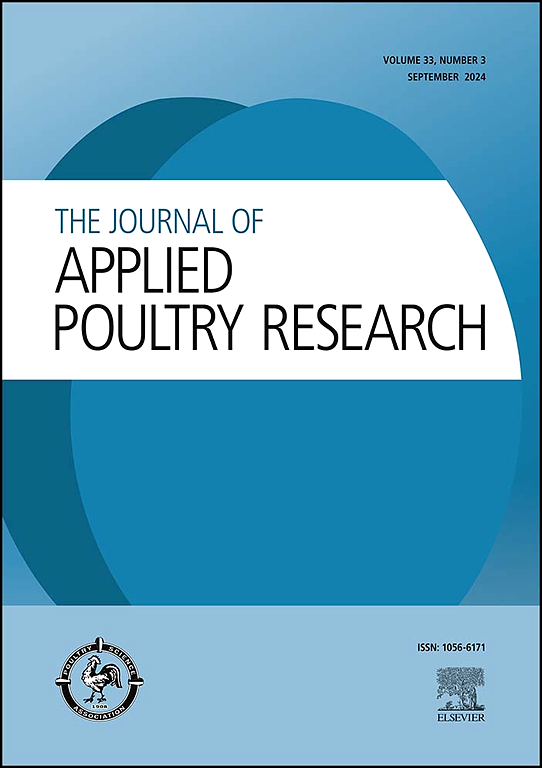提高饲粮营养密度不能恢复高油菜籽添加量肉鸡的生长性能
IF 2
3区 农林科学
Q2 AGRICULTURE, DAIRY & ANIMAL SCIENCE
引用次数: 0
摘要
减少采食量是肉鸡高含油籽产品日粮配制的主要挑战之一。建议提高饲粮营养密度,以弥补采食量减少造成的营养损失。因此,本研究旨在探讨在饲粮中添加较高的油菜籽产品,提高氨基酸和能量密度是否能恢复罗斯308肉鸡的生长性能。试验包括4种饲粮处理:以小麦-豆粕为基础的典型对照饲粮(T1),在发菜、生长育肥和断食饲粮中分别添加15%、20%、25%和30%的油菜籽产品的饲粮(T2),以及营养密度高于T2的两种饲粮(T3和T4)。在T3和T4阶段,营养物密度呈逐期递增趋势,T3增加1.5% ~ 3.0%,T4增加3.0% ~ 6.0%。体重增加(P <;0.001),采食量(P <;孵化后0 ~ 42 d饲粮处理对FCR (P = 0.003)和2.5 kg体重校正FCR (P = 0.007)均有影响。高水平的油菜籽产品降低了7.5%的采食量(4854克对4490克/只)和7.6%的增重(3301克对3049克/只);与对照组相比,体重校正后的FCR从1.485 g/g增加到1.538 g/g (T1)。适度增加营养密度(T3)不会改变高油菜籽产品添加量饲粮的生长性能,但进一步增加营养密度(T4)会使采食量降至4207 g/只。生长期采食量与颗粒耐久性指数(PDI)呈显著正相关(r = 0.700, P <;0.001), finisher (r = 0.700, P <;0.001),退出阶段(r = 0.656, P = 0.001)。然而,较高的油菜籽产品含量显著降低了每只鸟的饲料成本(P <;0.001)和每公斤体重饲料成本(P <;0.001),但增加了估计年龄,达到2.5 kg体重(P <;0.001)。随后,以菜籽油产品为基础的饲粮中营养密度的增加增加了每千克鸟类的饲料成本(P <;0.001)。综上所述,增加油菜籽饲粮中营养物质密度并不能恢复油菜籽添加率较高的肉鸡的生长性能。本文章由计算机程序翻译,如有差异,请以英文原文为准。
Increased dietary nutrient density did not restore growth performance in broiler chickens offered diets with high canola inclusion
Feed intake reduction is one of the key challenges in diets formulated with higher inclusions of canola products for broiler chickens. Increasing dietary nutrient densities was proposed to compensate for nutrient losses caused by decreased feed intake. Hence, this study investigated whether increasing amino acid and energy density in diets with higher inclusions of canola products restores growth performance in straight-run Ross 308 broiler chickens. The study included four dietary treatments: a typical wheat-soybean meal-based control diet (T1), a diet with high inclusions of canola products at 15, 20, 25, 30 % in starter, grower finisher and withdrawal diets, respectively (T2), and two diets (T3 and T4) with higher nutrient densities compared to T2. In T3 and T4, nutrient densities were progressively increased across phases, with T3 increasing by 1.5 % to 3.0 % and T4 increasing by 3.0 % to 6.0 %. Body weight gain (P < 0.001), feed intake (P < 0.001), FCR (P = 0.003), and body weight corrected FCR at 2.5 kg (P = 0.007) were influenced by the dietary treatment from 0 to 42 days post-hatch. Including high levels of canola product depressed feed intake by 7.5 % (4854 versus 4490 g/bird) and weight gain by 7.6 % (3301 versus 3049 g/bird); increased weight-corrected FCR from 1.485 to 1.538 g/g compared to control diets (T1). Moderate increase in nutrient density (T3) did not alter growth performance in the diet containing high canola product inclusion but the further increase of nutrient density (T4) depressed feed intake to 4207 g/bird. Feed intakes were positively correlated to pellet durability indices (PDI) in the grower (r = 0.700, P < 0.001), finisher (r = 0.700, P < 0.001), and withdrawal phases (r = 0.656, P = 0.001). Nevertheless, higher inclusions of canola products significantly decreased the cost of feed per bird (P < 0.001) and cost of feed per kg of BW (P < 0.001) but increased the estimated age to reach 2.5 kg of body weight (P < 0.001). Subsequently, increasing nutrient densities in canola product-based diets increased the cost of feed per kg of birds (P < 0.001). In conclusion, increasing nutrient density in canola-based diets did not restore growth performance in broiler chickens offered diets containing higher canola inclusion rate.
求助全文
通过发布文献求助,成功后即可免费获取论文全文。
去求助
来源期刊

Journal of Applied Poultry Research
农林科学-奶制品与动物科学
CiteScore
4.10
自引率
10.50%
发文量
80
审稿时长
104 days
期刊介绍:
The Journal of Applied Poultry Research (JAPR) publishes original research reports, field reports, and reviews on breeding, hatching, health and disease, layer management, meat bird processing and products, meat bird management, microbiology, food safety, nutrition, environment, sanitation, welfare, and economics. As of January 2020, JAPR will become an Open Access journal with no subscription charges, meaning authors who publish here can make their research immediately, permanently, and freely accessible worldwide while retaining copyright to their work. Papers submitted for publication after October 1, 2019 will be published as Open Access papers.
The readers of JAPR are in education, extension, industry, and government, including research, teaching, administration, veterinary medicine, management, production, quality assurance, product development, and technical services. Nutritionists, breeder flock supervisors, production managers, microbiologists, laboratory personnel, food safety and sanitation managers, poultry processing managers, feed manufacturers, and egg producers use JAPR to keep up with current applied poultry research.
 求助内容:
求助内容: 应助结果提醒方式:
应助结果提醒方式:


